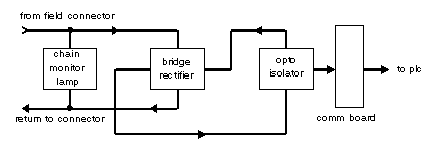True High input module B853–016 115-Vac/125-Vdc senses off and on input signals from its field circuitry, converting them to logic levels used by a PLC. The module’s 16 input circuits are divided into two groups of eight channels, each group being totally isolated from the other.
Although both groups use common return wires, none has a definite relationship to system ground unless established in the user’s field circuitry. Since both groups nominally employ independent power return sources, both ac and dc powered field circuits may directed to the module at the same time.
NOTE: Reversal of external signal polarity will not cause channel circuit damage as the circuit design is indifferent to accidental polarity reversal.
Following is a simplified schematic of the True High input module B853–016 115-Vac/125-Vdc
When the user’s ac/dc powered field circuit goes on—as the result of a limit switch, for example—it presents the field power voltage at the module’s appropriate input channel. When the input voltage meets or exceeds the module’s on threshold, the resulting voltage turns the channel monitor lamp on, current flows through the bridge rectifier and subsequently the opto-isolator (OPTO-ISOL) circuit.
Given a nominal 115 Vac/125 Vdc field power supply and a kΩ maximum input source impedance, the module’s channel monitor lamps will indicate on and off when input voltages are 80 Vac/85 Vdc for the high level on; and 35 Vac/40 Vdc for the low level off respectively.
The optical energy goes to the communications board (COMM BOARD) where the OURBUS output register is set to represent the field circuit’s on state. As long as the field input status remains true, the module will communicate this status each time it is polled by the controller. Total scan time may be as long as 250 ms. The user should not attempt to monitor events with a repetition rate greater than 1/s without analyzing his actual system, program, and scan time.
NOTE: It is possible to have the active indicator lit with one or more input channels working improperly.
